ESP MERCEDES-BENZ E-CLASS CABRIOLET 2020 User Guide
[x] Cancel search | Manufacturer: MERCEDES-BENZ, Model Year: 2020, Model line: E-CLASS CABRIOLET, Model: MERCEDES-BENZ E-CLASS CABRIOLET 2020Pages: 546, PDF Size: 44.79 MB
Page 47 of 546
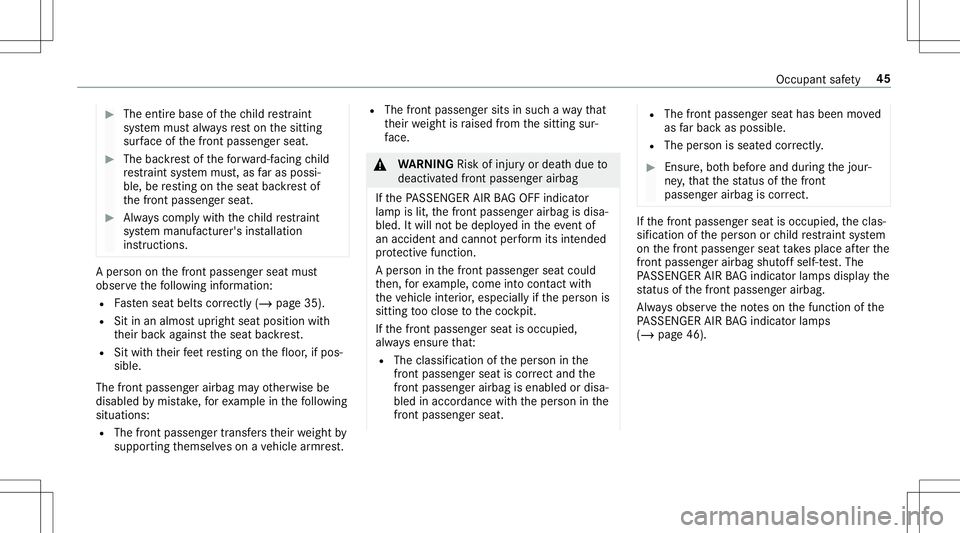
#
The entir ebase ofthech ild restra int
sy stem mus talw aysre st on thesitt ing
sur face ofthefront passeng erseat. #
The backres tof thefo rw ard-f acin gch ild
re stra int system mus t,as faras possi ‐
ble, beresting ontheseat backres tof
th efront passeng erseat. #
Alw ayscom plywit hth ech ild restra int
sy stem manuf acturer'sinstallation
ins truct ions . A
per son onthefront passeng erseat must
obser vethefo llo wing informatio n:
R Fasten seat belts correctl y(/ page 35).
R Sitinan almos tupr ight seatposi tion with
th eir bac kag ains tth eseat backres t.
R Sitwithth eir feet resting onthefloor ,if pos‐
sible.
The front passeng erairbag mayot her wise be
disabl edbymis take ,fo rex am ple inthefo llo wing
situat ions:
R The front passen gertr ansf ersth eir weight by
suppor tingthemselv eson ave hicle armr est. R
The front passeng ersits insuc hawa yth at
th eir weight israised from thesitt ing sur‐
fa ce. &
WARNIN GRisk ofinju ryor deat hdue to
deactiv ated front passeng erairbag
If th ePA SSENGER AIRBAGOF Find icat or
lam pis lit,th efront passeng erairbag isdisa‐
bled. Itwill notbe deplo yedin theeve ntof
an acci dent and canno tpe rfor m its intended
pr otect ive func tion.
A per son inthefront passeng erseat could
th en, forex am ple, com eint ocon tact with
th eve hicle interior ,especially ifth eper son is
sitt ing tooclose tothecoc kpit.
If th efront passeng erseat isoccupied,
alw aysensur eth at:
R The classificat ion oftheper son inthe
fr ont passeng ersea tis cor rect and the
fr ont passeng erairb agisenabl edordisa ‐
ble din accordance withth eper son inthe
fr ont passeng ersea t. R
The front passeng ersea thas been moved
as farbac kas possi ble.
R The person isseat edcor rectl y. #
Ensu re,bo th bef oreand during thejour‐
ne y,that thest atus ofthefront
passeng erairbag iscor rect. If
th efront passeng erseat isoccupied, theclas‐
sif ication oftheper son orchild restra int system
on thefront passeng erseat take splace afte rth e
fr ont passeng erairb agshut offself-t est.The
PA SSENGER AIRBAGind icat orlam psdispl aythe
st atus ofthefront passeng erairbag.
Alw aysobser vetheno teson thefunc tion ofthe
PA SSENGER AIRBAGind icat orlam ps
(/ page46). Oc
cupan tsaf ety 45
Page 49 of 546
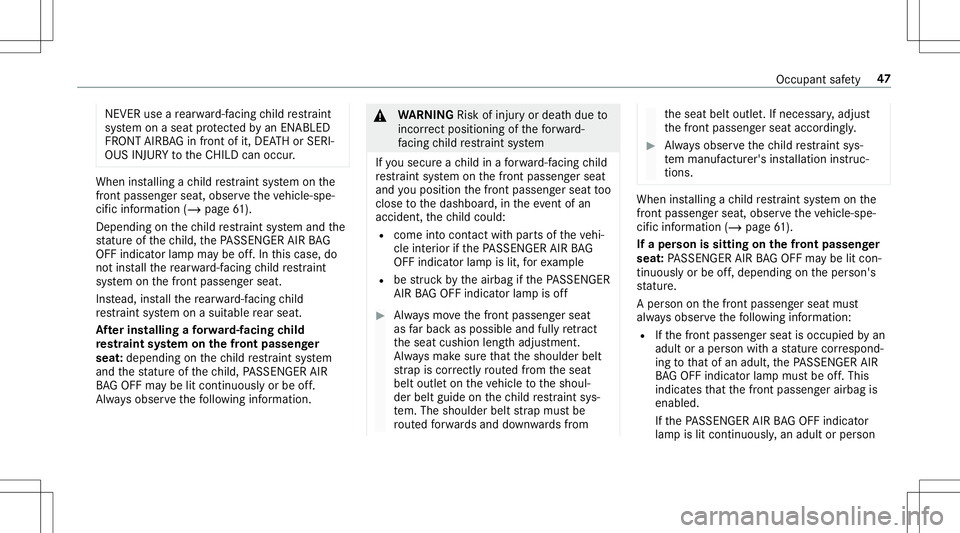
NEVER
useare ar wa rd-faci ng child restra int
sy stem onaseat protect edbyan ENABLED
FR ONT AIRB AG infront ofit,DE ATHor SERI‐
OUS INJURYtotheCH ILD can occur . When
installing ach ild restra int system onthe
fr ont passeng ersea t,obse rveth eve hicle-spe‐
cif icinf ormation (/page61 ).
De pend ing on thech ild restra int system and the
st atur eof thech ild, thePA SSENGER AIRBAG
OFF indicat orlam pma ybe off.In this case, do
no tins tallth ere ar wa rd-faci ng child restra int
sy stem onthefront passeng erseat.
Ins tead, installth ere ar wa rd-faci ng child
re stra int system onasuit able rear seat .
Af terin st alli ng afo rw ard-f acin gch ild
re stra int system onthefront passeng er
seat :depen dingonthech ild restra int system
and thest atur eof thech ild, PASSENGER AIR
BA GOF Fma ybe litcon tinuousl yor be off.
Alw aysobser vethefo llo wing informatio n. &
WARNIN GRisk ofinju ryor deat hdue to
inc orrect pos itioning ofthefo rw ard-
fa cing child restra int system
If yo usec ureach ild inafo rw ard-f acin gch ild
re stra int system onthefront passeng erseat
and youposi tionth efront passeng erseat too
clos eto thedashboar d,intheev ent ofan
acciden t,th ech ild could:
R com eint ocon tact with par tsof theve hi‐
cle interior ifth ePA SSENGER AIRBAG
OFF indicat orlam pis lit, forex am ple
R bestru ck bytheairbag ifth ePA SSENGER
AIR BAGOF Find icat orlam pis off #
Alw aysmo vethefront passeng erseat
as farbac kas possi bleand fully retract
th eseat cushion lengthadjus tment.
Alw aysmak esur eth at theshoulder belt
st ra pis cor rectly routed from theseat
belt outle ton theve hicle totheshoul‐
der belt guide onthech ild restra int sys‐
te m. The shou lderbeltstra pmus tbe
ro uted forw ards and down wardsfrom th
eseat beltoutle t.Ifneces sary,adjus t
th efront passeng erseat accor dingly. #
Alw aysobser vethech ild restra int sys‐
te m manuf acturer'sinstallation instruc‐
tion s. When
installing ach ild restra int system onthe
fr ont passeng ersea t,obse rveth eve hicle-spe‐
cif icinf ormation (/page61 ).
If aper son issit tin gon thefront passeng er
seat :PA SSENGER AIRBAGOF Fma ybe litcon ‐
tin uousl yor be off,depen dingon theper son's
st atur e.
A per son onthefront passeng erseat must
alw aysobser vethefo llo wing informatio n:
R Ifth efront passeng erseat isoccupied byan
adult oraper son withast atur ecor respond‐
ing tothat ofan adult ,th ePA SSENGER AIR
BA GOF Find icat orlam pmus tbe off.This
ind icat esthat thefront passeng erairbag is
enabled.
If th ePA SSENGER AIRBAGOF Find icat or
lam pis lit con tinuousl y,an adult orper son Oc
cupan tsaf ety 47
Page 50 of 546

wit
habuild corresponding tothat ofan adult
shoul dno tuse thefront passeng erseat.
Ins tead, they should useare ar seat .
R Ifth efront passeng erseat isoccupied bya
per son ofsmaller statur e(e. g.ate enag eror
small adult), thePA SSENGER AIRBAGOF F
ind icat orlam peit her light sup con tinuousl y
or remains off,depe nding onthere sult ofthe
cla ssificati on.
- Ifth ePA SSENGER AIRBAGOF Find icat or
lam pis off:mo vethefront passeng er
seat asfarbac kas possi ble,ortheper‐
son ofsmaller statur eshoul duse are ar
seat .
- Ifth ePA SSENGER AIRBAGOF Find icat or
lam pis lit con tinuousl y:theper son of
smaller statur eshoul dno tuse thefront
passeng erseat. &
WARNIN GRisk ofinju ryor deat hwhen
th ePA SSENGER AIRBAGOF Find icat or
lam pis lit
If th ePA SSENGER AIRBAGOF Find icat or
lam pre mains litafte rth esy stem self-t est,
th efront passeng erair bag isdeactiv ated. It
will notbe deplo yedin theeve ntofan acci ‐
de nt. Inthis case, thefront passeng erair bag
cann otper form itsintended protect ive func ‐
tion ,e.g. when aper son isseat edinthefront
passeng erseat.
That person could, forex am ple, com eint o
con tact with theve hicle interior ,especially if
th eper son issitt ing tooclose tothecoc kpit.
If th efront passeng erseat isoccupied,
alw aysensur eth at:
R The classificat ion oftheper son inthe
fr ont passeng ersea tis cor rect and the
fr ont passeng erair bag isenabl edor
dea ctivated inaccor dance withth eper‐
son inthefront passeng erseat. R
The person isseat edproper lywit hacor ‐
re ctly fastened seatbelt.
R The front passeng erseat hasbeen moved
as farbac kas possi ble. Be
sureto also obse rveth efo llo wing further
re lat ed subje cts:
R Child restra int system onthefront passeng er
seat (/page61 ). Ro
llbar &
DANG ER Risk ofinjuryor deat hcause d
by amalf unctionof thero llbar s
If th efunc tion ofthero llbar sis def ect ive,
th ey ma yno tex tend inan acci dent forex am‐
ple.
Con sequent ly,th ero llbar scan notpr otect
ve hicle occupants asthey aredesig nedto
do. #
Have thero llbar sch eckedimmediat ely
at aqu alif ied spec ialistwo rkshop. 48
Occupant safety
Page 55 of 546
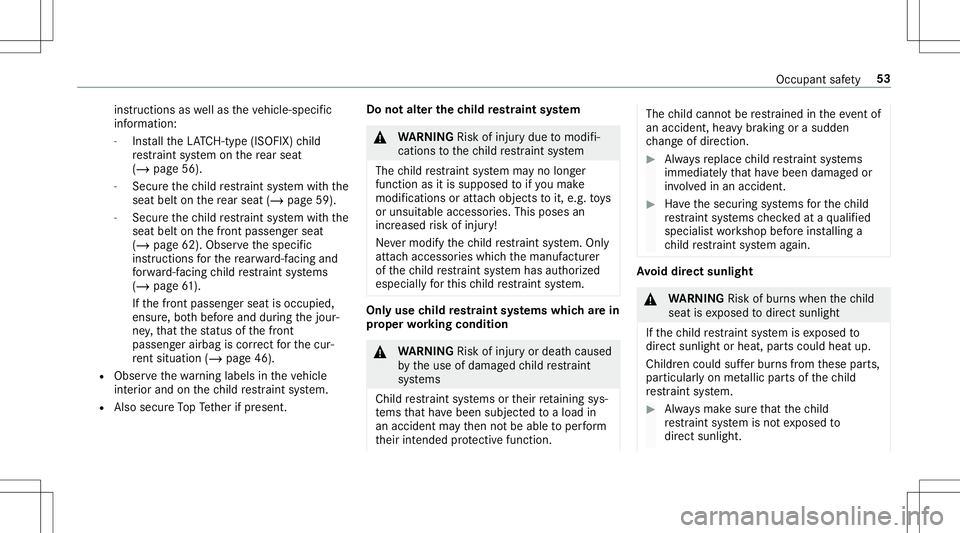
ins
truct ions aswellas theve hicle-specif ic
inf ormation:
- Installth eLA TC H-type (ISOFIX )ch ild
re stra int system onthere ar seat
(/ page56 ).
- Sec ureth ech ild restra int system withth e
seat beltonthere ar seat (/page59 ).
- Sec ureth ech ild restra int system withth e
seat beltonthefront passeng erseat
(/ page62). Obser vethespecif ic
ins truction sfo rth ere ar wa rd-faci ng and
fo rw ard-f acin gch ild restra int systems
(/ page61 ).
If th efront passeng erseat isoccupied,
ensur e,bo th bef oreand during thejour‐
ne y,that thest atus ofthefront
passeng erairbag iscor rect forth ecur‐
re nt situa tion(/ page 46).
R Obse rveth ewa rning labels intheve hicle
int erior and onthech ild restra int system.
R Also secur eTo pTe ther ifpr esent . Do
notalt er thech ild restra int system &
WARNIN GRisk ofinju rydue tomodif i‐
cations tothech ild restra int system
The child restra int system mayno long er
func tion asitis supposed toifyo umak e
mod ificat ionsor att achobj ect sto it,e.g. toys
or unsuit ableaccessor ies.This poses an
incr eased risk ofinjur y!
Ne vermodify thech ild restra int system. Only
att achaccessor ieswhic hth emanuf acturer
of thech ild restra int system has author ized
especially forth is ch ild restra int system. Onl
yuse child restra int systems whichar ein
pr oper working condit ion &
WARNIN GRisk ofinju ryor deat hcaused
by theuse ofdamag edchild restra int
sy stems
Child restra int systems ortheir retainin gsy s‐
te ms that have been subjec tedto aload in
an acc iden tma yth en notbe able toper form
th eir intended protect ive func tion. The
child can notbe restra ined intheev ent of
an acciden t,hea vybraking orasudden
ch ang eof dir ect ion. #
Alw aysre place child restra int systems
immediat elyth at have been damag edor
in vo lved inan acciden t. #
Have thesecur ingsystems forth ech ild
re stra int systems checkedat aqu alif ied
spec ialistwo rkshop beforeins talling a
ch ild restra int system again. Av
oid direct sunli ght &
WARNIN GRisk ofburnswhen thech ild
seat isex posed todirect sunlight
If th ech ild restra int system isex posed to
dir ect sunlight orheat, partscould heatup.
Childr encould sufferbur nsfrom these parts,
par ticular lyon metallic partsof thech ild
re stra int system. #
Alw aysmak esur eth at thech ild
re stra int system isno tex posed to
dir ect sunlight . Occ
upant safety 53
Page 58 of 546
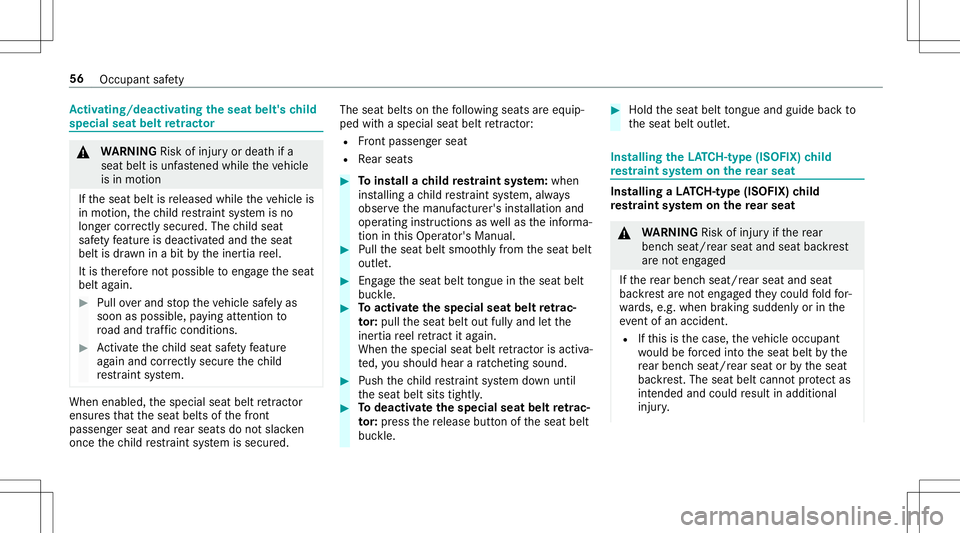
Ac
tiv atin g/deac tivatin gthe seat belt's child
special seatbeltretract or &
WARNIN GRisk ofinju ryor deat hif a
seat beltisunf astened while th eve hicle
is in mo tion
If th eseat beltisreleased whiletheve hicle is
in mo tion, thech ild restra int system isno
long ercor rectl ysecu red. The child seat
saf etyfe atur eis deac tivated and theseat
belt isdraw nin abi tby theiner tiareel.
It is ther efor eno tpossible toeng ageth eseat
belt again. #
Pull overand stop theve hicle safely as
soon aspossible, paying attention to
ro ad and traffic condi tions. #
Activateth ech ild seat safetyfe atur e
ag ain and correctl ysecu rethech ild
re stra int system. When
enabled, thespecial seatbeltretract or
ens ures that theseat belts ofthefront
passeng erseat andrear seat sdo notslac ken
once thech ild restra int system issecur ed. The
seat belts onthefo llo wing seats areeq uip‐
ped withaspec ialseat beltretract or:
R Front passeng erseat
R Rear seat s #
Toins tall ach ild restra int system: when
ins talling ach ild restra int system, always
obser vethemanuf acturer'sinstallation and
opera tingins truct ions aswellas theinf orma‐
tion inthis Oper ator's Manual. #
Pull theseat beltsmoo thly from theseat belt
outle t. #
Engage theseat belttongu ein theseat belt
buc kle. #
Toactiv ateth especia lseat beltretrac‐
to r:pull theseat beltoutfully andletth e
iner tiareel retract itag ain.
Wh enthespecial seatbeltretract orisacti va‐
te d, yousho uld hear ara tche ting sound. #
Push thech ild restra int system down until
th eseat beltsitstight ly. #
Todeac tivatethe special seat beltre trac‐
to r:press there lease buttonoftheseat belt
buc kle. #
Hold theseat belttongu eand guide ba ck to
th eseat beltoutle t. Ins
talling theLA TC H-type (ISOFI X)child
re stra int system onthere ar seat Ins
tallingaLA TC H-type (ISOFI X)child
re stra int system onthere ar seat &
WARNIN GRisk ofinju ryifth ere ar
ben chseat/r earseat andseat backres t
ar eno teng aged
If th ere ar ben chseat/r earseat andseat
bac kres tar eno teng aged they cou ldfold for‐
wa rds, e.g. when braking suddenly orinthe
ev ent ofan acciden t.
R Ifth is isthecase, theve hicle occupant
wo uld beforc ed intoth eseat beltbythe
re ar ben chseat/r earseat orby theseat
bac kres t.The seat beltcann otprotect as
int ended andcould result inadditional
injur y. 56
Occupant safety
Page 63 of 546
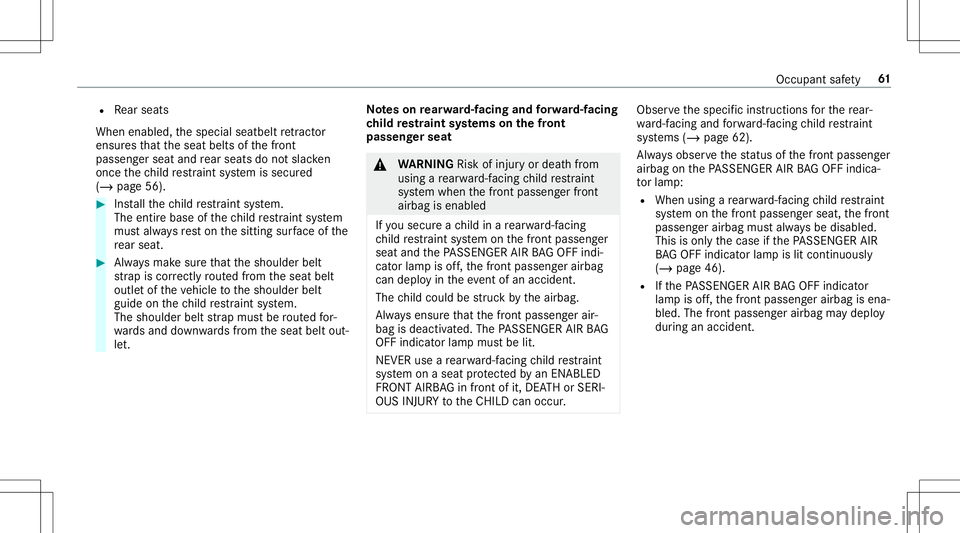
R
Rear seat s
When enabled,thespecial seatbelt retract or
ens ures that theseat belts ofthefront
passeng erseat andrear seat sdo notslac ken
once thech ild restra int system issecur ed
(/ page56). #
Installth ech ild restra int system.
The entire base ofthech ild restra int system
mus talw aysre st on thesitt ing surface ofthe
re ar seat . #
Alw aysmak esur eth at theshoulder belt
st ra pis cor rectly routed from theseat belt
outle tof theve hicle totheshoulder belt
guide onthech ild restra int system.
The shoulder beltstra pmus tbe routed for‐
wa rdsand down wardsfrom theseat beltout‐
le t. No
teson rear wa rd-faci ng and forw ard-f acin g
ch ild restra int systems onthefront
pa sseng erseat &
WARNIN GRisk ofinju ryor deat hfrom
using are ar wa rd-faci ng child restra int
sy stem when thefront passeng erfront
airbag isenabled
If yo usec ureach ild inare ar wa rd-faci ng
ch ild restra int system onthefront passeng er
seat andthePA SSENGER AIRBAGOF Find i‐
cat orlam pis off,th efront passeng erairbag
can deplo yin theev ent ofan acciden t.
The child could bestru ck bytheairbag.
Alw aysensur eth at thefront passeng erair‐
bag isdeactiv ated. The PASSENGER AIRBAG
OFF indicat orlam pmus tbe lit.
NEVER useare ar wa rd-faci ng child restra int
sy stem onaseat protect edbyan ENABLED
FR ONT AIRB AG infront ofit,DE ATHor SERI‐
OUS INJURYtotheCH ILD can occur . Obser
vethespecif icins truction sfo rth ere ar‐
wa rd-faci ng and forw ard-f acin gch ild restra int
sy stems (/page62).
Alw aysobser vethest atus ofthefront passeng er
airbag onthePA SSENGER AIRBAGOF Find ica‐
to rlam p:
R When using are ar wa rd-faci ng child restra int
sy stem onthefront passeng erseat, thefront
passeng erairbag mustalw aysbe disabl ed.
This isonl yth ecase ifth ePA SSENGER AIR
BA GOF Find icat orlam pis lit con tinuousl y
(/ page46) .
R Ifth ePA SSENGER AIRBAGOF Find icat or
lam pis off,th efront passeng erairbag isena‐
bled. Thefront passeng erairbag maydeplo y
dur ing anacciden t. Occ
upant safety 61
Page 64 of 546

Secur
ingthech ild restra int system withth e
seat beltonthefront passeng erseat
When installing abelt- secur edchild restra int
sy stem onthefront passeng erseat, always
obser vethefo llo wing:
0073 Obser
vethech ild restra int system manuf ac‐
tur er's installation andoper atingins truc‐
tion s.
0073 When
usingafo rw ard-f acin gch ild restra int
sy stem inGroup I:re mo vethehead
re stra int from there spectiv eseat, ifpossi‐
ble.
Af terth ech ild restra int system has been
re mo ved, replace thehead restra int simme‐
diat elyand adjus tth em correctly .
0073 The
backrest of thefo rw ard-f acin gch ild
re stra int system mus tlie asflat as poss ible
ag ains tth ebac kres tof thefront -passen ger
seat.
0073 Fo
rcer tain child restra int systems inwe ight
cat egor yII or III,th er ema ybe restrictions
on themaximum sizesetting, e.g. due to
possible contact with thero of. 0073
The
child restra int system mus tno tbe ten‐
si oned betwee nth ero of and theseat cush‐
ion and/or beinstalled facing thewr ong
dir ect ion. Adjus tth eseat backres tinclin a‐
tion accor dingly.
0073 The
child restra int system mus tno tbe put
under stra in by thehead restra int s.Ad jus t
th ehead restra int sacc ording ly.
0073 Ne
verpla ceobjects underorbehi ndthe
ch ild restra int system, e.g.cushions .
The seat beltonthefront passeng erside is
eq uipped withaspecial seatbeltretract or.
Wh enena bled ,th especial seatbeltretract or
ens ures that theseat beltdoes notslac kenonce
th ech ild restra int system issecur ed
(/ page56). #
Setth efront passeng erseat asfarbac kas
possi bleand movetheseat intoth ehighes t
position ifpossible. #
Fully re tract theseat cushion lengthadjus t‐
ment . #
Adjus tth eseat cushion inclination sothat
th efront edgeof theseat cushion isin the highes
tposition andthere ar edg eof the
seat cushion isin thelowe stposition . #
Setth eseat backres tto an almos tve rtical
posit ion. #
Installth ech ild restra int system.
The entire base ofthech ild restra int system
mus talw aysre st on theseat cushion ofthe
fr ont-passe nger sea t. #
Alw aysmak esur eth at theshoulder belt
st ra pis cor rectly routed from theseat belt
outle tof theve hicle totheshoulder belt
guide onthech ild restra int system.
The shoulder beltstra pmus tbe routed for‐
wa rdsand down wardsfrom theseat beltout‐
le t. #
Ifneces sary,adjus tth eseat beltoutle tand
th efront passeng erseat accor dingly. 62
Occupant safety
Page 66 of 546
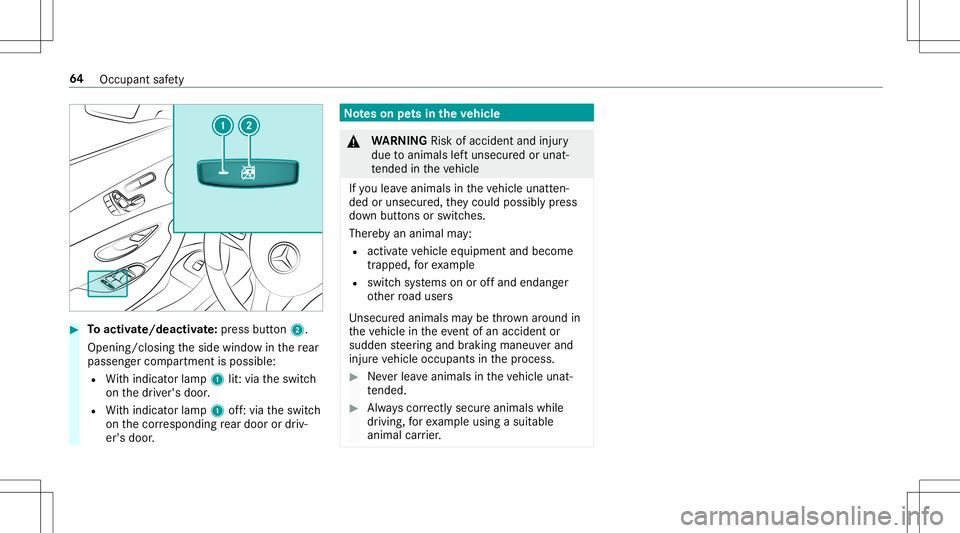
#
Toactiv ate/ deacti vate:pr ess button 2.
Op eni ng/cl osing theside windo win there ar
passe nger com partment isposs ible:
R With indic ator lam p1 lit:via theswitc h
on thedr iver's door .
R With indic ator lam p1 off:via theswitc h
on thecor responding rear door ordriv‐
er' sdoor . No
teson pets intheve hicl e &
WARNIN GRisk ofacci dent andinjury
due toanim alsleftuns ecur edorunat ‐
te nde din theve hicle
If yo ulea veanim alsintheve hicle unatten‐
ded orunsecur ed,they cou ldpos siblypress
do wn butt ons orswitc hes.
Ther ebyan animal may:
R activ ateve hicle equipment andbecome
tr apped, forex am ple
R swit chsystems onoroffand endang er
ot her road user s
Uns ecur edanimals maybe throw nar ou nd in
th eve hicle intheeve ntofan acci dent or
su dd en steer ing and braking maneuv erand
injur eve hicle occupants inthepr ocess. #
Neverlea veanim alsintheve hicle unat‐
te nde d. #
Alw ayscor rectly secu reanim alswhile
dr ivin g,forex am ple usin gasuit able
anim alcar rier . 64
Occupant safety
Page 76 of 546
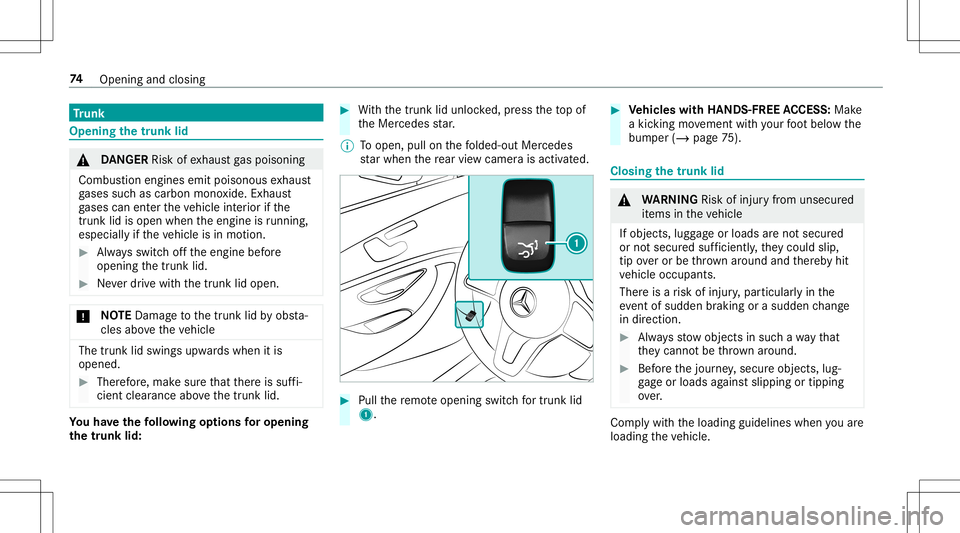
Tr
unk Openi
ngthetrunk lid &
DANG ER Risk ofexhaus tga spoisoning
Combus tionengines emitpoisonous exhaus t
ga ses suchas carbon monoxide.Exhaus t
ga ses can entertheve hicle interior ifth e
tr unk lid is op en when theengine isrunning ,
esp ecially ifth eve hicle isin mo tion. #
Alw aysswitc hof fth eengine before
opening thetrunk lid. #
Neverdr ive wit hth etrunk lidopen. *
NO
TEDama getothetrunk lidbyobs ta‐
cle sab ove theve hicle The
trunk lidswings upwards when itis
opened. #
Ther efor e, mak esur eth at ther eis suf fi‐
cie ntcle arance above thetrunk lid. Yo
uha ve thefo llo wing options forope ning
the trunk lid: #
With thetrunk lidunloc ked, press theto pof
th eMer cedes star.
% Toopen, pullonthefo lded-o utMer cedes
st ar when there ar vie wcam erais act ivat ed. #
Pull there mo teopening switchfo rtr unk lid
1. #
Vehicl eswith HANDS -FREEACCESS: Make
a kic kin gmo vement withyo ur foot belo wthe
bum per(/ page75 ). Closing
thetrunk lid &
WARNIN GRisk ofinju ryfrom unsecu red
it ems intheve hicle
If object s,lugg ageor loads areno tsecur ed
or notsecur edsuf ficie ntly,they cou ldslip,
tip ove ror be throw nar ou nd and ther eb yhit
ve hicle occupants.
Ther eis arisk ofinjur y,par ticular lyin the
ev ent ofsudden braking orasudden chang e
in dir ect ion. #
Alw aysst ow object sin suc hawa yth at
th ey canno tbe thro wn around. #
Beforeth ejour ney,secur eobjects, lug‐
ga ge orloads agains tslipping ortipping
ove r. Com
plywit hth eloading guidelines whenyouar e
loadin gth eve hicle. 74
Opening andclosing
Page 80 of 546

#
Onlyload thetrunk belowthetrunk
separ ator so that itwill notbe pushe d
upw ards. #
Mak esur eth at thetrunk lidisclosed. #
Ifth esof tto pis dir ty,we tor froze n,do
no top en thesof tto p. *
NO
TEDama getothesof tto pcaused by
hea vyobjects Hea
vyobject splaced onthesof t-to pcom‐
par tmen tco vercan dama gethesof tto por
sof t-to pcom partmen tco ver. #
Donotpl ace heavyobj ects on thesof t-
to pcom partmen tco ver. #
Donotsi ton thesof t-to pcom partmen t
co ver. Fo
rsaf etyre ason s,Mer cedes-Ben zre comme nds
ope ning orclos ingthesof tto pwhen theve hicle
is statio nary.
To open orclose thesof tto pwhile youar edr iv‐
ing ,do notexc eed amaximum speedof30 mph
(50 km/ h).Toavo idint erru pting theclosing pr
ocess whileyouar esligh tly ex ceed ingthis
speed, donotdr ive at aspeed great erthan
37 mph(60 km/h). #
Mak esur eth at thetrunk partition isclosed. #
Close thetrunk lid. #
Switc hon theignition . #
Keep thebr ak epedal depressed whenthe
ve hicle isstatio nary. #
Toopen: pulland hold soft-to pswitc h1
until thesof tto pis full yopen.
The multifun ction displa ysho wstheopening
pr ocess ofthesof tto p. #
Toclose: press and hold soft-to pswitc h1
until thesof tto pis full yclosed.
The multifun ction displa ysho wstheclosing
pr ocess ofthesof tto p. &
WARNIN GRisk ofacci dent dueto
exc essiv espeed during thesof t-to p
opening orclosing procedur e
If th eve hicle speed exceeds 37mph
(60 km/ h),thesof tto pstops during the
opening orclosing procedur e.
This impair syo ur vie wto there ar. #
Reduce theve hicle speed tobelo w
37 mph(60 km/h) orstop theve hicle,
pa ying attention toroad and traf fic con‐
di tions . #
Ope rate thesof t-to pswitc hag ain in
or der toopen orclose thesof tto pfull y. 78
Opening andclosing